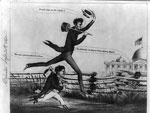At a Glance
Teacher Review
Topics
Website
Features
Duration
Grade(s)
Lesson Format
Download
The Multiple Dilemmas of Abraham Lincoln
The lesson plan revolves around an interactive website that will provide students with a more 'humanized' view of Abraham Lincoln.
Review

This lesson, an interactive historical simulation, presents students with five difficult decisions Abraham Lincoln made between his election in November 1860 and the battle of Fort Sumter in April 1861. The strength of this lesson is the wealth of primary and secondary source evidence that it uses to help students understand the challenging questions Lincoln faced.
This lesson is designed for students to complete online, but can be modified for classrooms that lack computer access. It is presented through five online modules, each centered around a different dilemma. All modules provide students with historical background, an explanation of the issues facing Lincoln and resources that shed light on some of the information Lincoln had to consider when making the decision.
Students are given a list of the likeliest decision options available to Lincoln, but are also encouraged to come up with their own solutions for these historical dilemmas. Of particular value, is the ability to read about Lincoln’s actual decision and compare it to student generated ones.
Due to the length of this lesson and its reliance on computers, we recommend that teachers consider focusing on only one of the decisions, printing out only the relevant resources to use in class.
The authors of this lesson note the shortcomings of historical simulations, pointing out that students’ simulated policy decisions might be colored by presentism and hindsight. Rather than a simulation, teachers could use these materials to examine the issues Lincoln faced and his responses, and then use the documents to evaluate why Lincoln responded as he did.
Notes
| Field | Criteria | Comments | ||
|---|---|---|---|---|
| Historical Content | Is historically accurate? | Yes |
||
| Includes historical background? | Yes |
|||
| Requires students to read and write? | Yes |
|||
| Analytic Thinking | Requires students to analyze or construct interpretations using evidence? | Yes This is the heart of the lesson—using evidence to understand decisions made by Lincoln. |
||
| Requires close reading and attention to source information? | Yes |
|||
| Scaffolding | Is appropriate for stated audience? | Yes |
||
| Includes materials and strategies for scaffolding and supporting student thinking? | Yes |
|||
| Lesson Structure | Includes assessment criteria and strategies that focus on historical understanding? | Yes |
||
| Defines clear learning goals and progresses logically? | Yes |
|||
| Includes clear directions and is realistic in normal classroom settings? | No |
|||